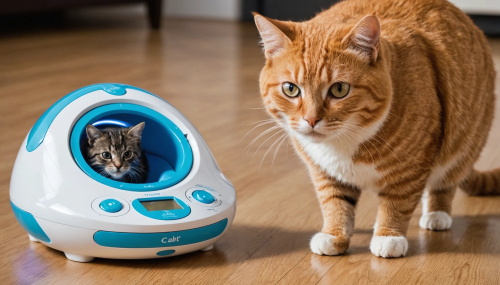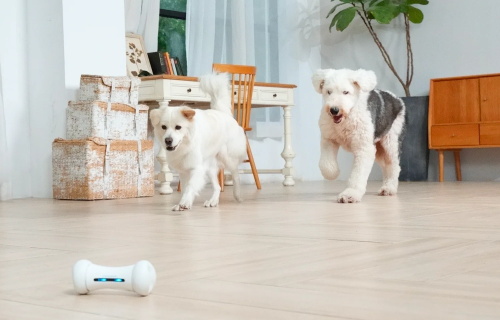How Augmented Reality and Smart Toys Are Changing Pet Playtime?

As the world of pet care continues to evolve, technology is bringing a variety of innovative ways to enhance the lives of our furry companions. Among these advancements, augmented reality (AR) and smart toys have emerged as game-changers, transforming traditional playtime into interactive and engaging experiences.
What is augmented reality (AR)?
Augmented reality (AR) is a technology that overlays digital information (such as images, sounds, or other sensations) onto the real world. Unlike virtual reality, which creates a completely digital environment, AR enhances our perception of the real world by incorporating interactive digital elements. When applied to pet playtime, AR can transform a simple living room into a vibrant playground filled with virtual balls, mice, or laser pointers that react to your pet's movements.
Imagine a cat chasing a virtual butterfly projected on a tablet screen, or a dog following the trajectory of a digitally generated ball. AR brings these experiences to life, providing mental stimulation and entertainment that traditional toys often can't match.
What are smart toys?
Smart toys are interactive toys equipped with sensors, motors, internet connectivity, and sometimes even artificial intelligence. They respond to pets' movements, enabling dynamic interactions. Unlike standard, stationary toys, smart toys can move autonomously, make sounds, and even "learn" a pet's play style, adjusting their behavior accordingly.
For example, when a dog loses interest, a smart toy might accelerate or change direction, or emit sounds to entice a cat to chase. This responsiveness transforms playtime into a truly interactive experience, keeping pets engaged for longer.

The Impact of AR and Smart Toys on Pet Playtime
1. Enhanced Mental Stimulation
Pets, especially cats and dogs, require intellectual challenges to stay sharp and avoid behavioral problems. Augmented reality and smart toys provide complex stimulation, prompting pets to think and solve problems. For example, some AR apps allow dogs to "catch" virtual objects that appear in different locations, improving their cognitive abilities and focus.
A 2024 study in the International Journal of Animal Behavior highlighted that dogs who interacted with motion-activated smart toys showed a 30% improvement in problem-solving skills compared to those who played with traditional toys. Mental stimulation can reduce boredom and help prevent destructive behaviors such as chewing furniture or excessive barking.
2. Physical Exercise and Activity
Physical activity is crucial for pet health, and many smart toys are designed to encourage it. Automatic balls, laser pointers, and robotic companions allow pets to run, pounce, and chase in a way that mimics outdoor play. For indoor pets, these toys are crucial for maintaining a healthy weight, building muscle tone, and promoting cardiovascular health.
Cats are particularly drawn to toys that mimic the movements of prey. Smart toys that chug around the room can mimic the behavior of birds or mice, stimulating their natural hunting instincts. This type of play not only keeps cats physically active but also mentally fulfilling.
3. Emotional Health
Play is not only fun but also promotes a pet's emotional well-being. Pets left alone for extended periods of time may develop separation anxiety or stress-related behaviors. Augmented reality (AR) and smart toys can serve as companions for pets, providing stimulation and comfort while their owners are away. The ability to remotely interact with toys or monitor pet play through an app can also alleviate owners' anxiety about leaving their pets alone.
Pet psychologists note that interactive toys can foster a stronger bond between pets and owners, even across distance. "Pets love interaction. When toys respond to their behavior, it feels like a dynamic, engaging interaction, which can reduce feelings of loneliness," says Dr. Emily Harper, a certified animal behaviorist.

Benefits of AR and Smart Toys for Pet Owners
1. Convenience and Control
App-controlled toys allow owners to remotely manage playtime. This is especially useful for busy professionals or families with irregular schedules. By ensuring pets stay active and engaged, owners can maintain their pet's health and happiness without having to be physically present.
2. Customizable Play Experience
Many smart toys are customizable. Owners can adjust the speed, difficulty, and play mode based on their pet's energy level and personality. For example, an energetic puppy might thrive in a high-speed chase mode, while an older dog might prefer a slower, more predictable movement mode.
3. Monitoring and Feedback
Some smart toys collect pet playtime and activity data. This information can inform owners of health concerns, such as decreased activity or lethargy, which may indicate underlying health issues. Monitoring tools can help owners intervene early, thereby contributing to preventative healthcare.
4. Strengthening the Human-Animal Bond
Even during busy days, interactive toys can serve as a bridge for owners and pets to interact. Shared playtime fosters trust and strengthens the emotional bond, thereby enhancing the overall relationship between pet and owner.
The Future of Pet Play: The Fusion of AI and Augmented Reality
Personalized Play
Next-generation toys are expected to incorporate AI, delivering a fully personalized experience. These toys will learn pets' play styles, adapt to their preferences, and adjust interactions to maintain engagement. For example, AI toys can recognize when a dog is bored with a certain action and switch to a new mode to rekindle their interest.
Immersive AR Worlds
AR technology will also continue to advance, creating complex, immersive play environments. Pets may be able to interact with multi-layered virtual environments, such as virtual treasure hunts or obstacle courses, enhancing intellectual stimulation and problem-solving skills.
Social Play
Some augmented reality and smart toys may include multi-pet interaction features, allowing pets from different households to virtually play together. This is especially valuable for social animals, who can experience social stimulation even when physically separated from their companions.
Expert Insight
Animal behaviorists emphasize that technology should complement, not replace, traditional play. "While augmented reality and smart toys are wonderful tools, pets still need real-world interactions, walks, and tactile experiences," notes Dr. Harper. "Combining physical, social, and digital play ensures a well-rounded lifestyle for pets."
Veterinarians also emphasize the health benefits of these toys. Regular interactive play can prevent obesity, reduce destructive behaviors, and improve overall mental and emotional well-being.
The advent of augmented reality and smart toys has ushered in a new era of pet play, providing our furry friends with richer mental stimulation, physical activity, and emotional well-being. From interactive robotic companions to immersive AR experiences, these innovations are redefining how pets interact with their environments. As AI and AR technologies continue to advance, the possibilities for enriching pet playtime are endless.
By using these tools responsibly, pet owners can provide their pets with engaging, fulfilling, and healthy experiences. Beyond pure entertainment, AR and smart toys can help build stronger human-animal bonds, leading to happier pets and providing smarter, healthier, and more active lives for our beloved furry family members.



